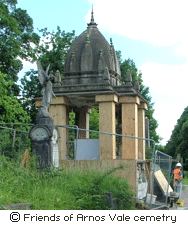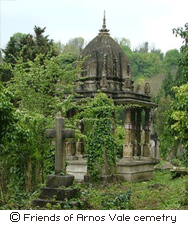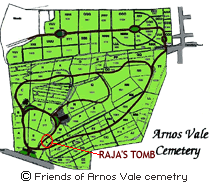 June 15 June 15
The whole monument is now covered with scaffolding, the pillars are encased by wood, and I hope that the main work will begin on week of 23rd June. I will be there of course seeing the work as it progresses, camera at the ready.
2 weeks ago the conservation firm dug into the main left side wall of the platform to gain access into what we all expected would be the  brick built vault where the coffin lies. To everyone`s surprise the coffin was not to be seen under the chattri, but obviously lies much deeper down, ie. more than 6 feet underground. A spyhole was bored down to that depth and there is a second chamber but the excavation work needed ,plus the propping up of the whole structure (which would then include the whole of the platform and the 4 side walls ) would have been enormously expensive had we gone down that far. So reluctantly we had to leave the Rajah to rest undisturbed in his chamber. After all the Rajah had already been reinterred once already... brick built vault where the coffin lies. To everyone`s surprise the coffin was not to be seen under the chattri, but obviously lies much deeper down, ie. more than 6 feet underground. A spyhole was bored down to that depth and there is a second chamber but the excavation work needed ,plus the propping up of the whole structure (which would then include the whole of the platform and the 4 side walls ) would have been enormously expensive had we gone down that far. So reluctantly we had to leave the Rajah to rest undisturbed in his chamber. After all the Rajah had already been reinterred once already...
Rereading Mary Carpenter`s "Last Days" I now understand why she wrote that the body in its coffin was reinterred in Arnos Vale from Stapleton Grove and buried in a brick built vault. What I had not appreciated was that this vault was dug so deep underground. However since the chattri  superstructure was not erected for another 2/3 years, I realise that the coffin and body needed to rest in a deep and safe place until that superstructure was raised over the site. At the time in England it was the custom to bury eminent people or the well -to -do in vaults, and the bigger the vault the more other members of the family could be put there as they died in the course of time. The Rajah simply had an exceptionally deep vault, but not a large one since obviously it was not envisaged that other family members would follow him here to die in Bristol. superstructure was not erected for another 2/3 years, I realise that the coffin and body needed to rest in a deep and safe place until that superstructure was raised over the site. At the time in England it was the custom to bury eminent people or the well -to -do in vaults, and the bigger the vault the more other members of the family could be put there as they died in the course of time. The Rajah simply had an exceptionally deep vault, but not a large one since obviously it was not envisaged that other family members would follow him here to die in Bristol.
As it is the dome of the chattri is presently supported on steel scaffolding preparing for the removal of the 12 pillars which hold up the dome. Many of these pillars have split stone covers, and one of these has had its outer stone casing removed to reveal an iron central pillar core which has rusted badly and so expanded. All these old iron cores need to be removed and replaced , perhaps with non rusting metal rods , and then the stone casing must be replaced to make it look as before.
Various people have been taking pictures of all the stages thus far, and I will collect them all together in  due course and send them off to you in hard copy later ,together with a detailed explanation of what has been done and why. I am obviously disappointed not to have seen the coffin, but the costs to have dug down to where it is were way beyond what we have from the kind Poddars, and we thought that our priority must be to restore and safeguard the tomb for the years to come and so that should be where the money is spent. due course and send them off to you in hard copy later ,together with a detailed explanation of what has been done and why. I am obviously disappointed not to have seen the coffin, but the costs to have dug down to where it is were way beyond what we have from the kind Poddars, and we thought that our priority must be to restore and safeguard the tomb for the years to come and so that should be where the money is spent.
The tomb is grade 2* listed by English Heritage, which means that they have the final say over what may or may not be done to it. I am trying to get the stone of the chattri cleaned at a reasonable price and some objectionable purple and green paint removed off the pillars and filials but I am not sure as yet if we have the money for this or if it will be allowed. I will keep you informed on all this.
June 20
I spent some time at Arnos Vale 2 days back speaking with the 2 conservation / restoration stone masons who are actually doing this stage of the work. I am glad to report that the horrid green and purple paint, which to my mind disfigured the chattri, is in the process of being removed. Under it gold paint has been uncovered, but in bad condition. It dates I know from 1871 when a Mr Chatterji (descended from the Rajah`s daughter) had some work done to the tomb. We have a photo of Mr. C. at Arnos Vale standing by the tomb with an absolutely enormous wreath which he had obviously just laid at the front of the chattri. The gold paint too is to be removed and the chattri thus restored to its original condition as paid for by Dwarkanath Tagore and as designed by Wm. Princep. I am now trying to get a much later epitaph to the Rajah (which displaced the original epitaph with Tagore`s wording on the front of the tomb ) switched around and so the correct plaque is restored to the front. For this I need the permission of English Heritage, who guards all listed monuments, and says yea or nay to any changes to them.
The next stage of the restoration is to carefully remove the 12 stone columns, take out their rusted iron interior bars and replace the latter with stainless steel bars and then reclad the pillars with as much of the original stone as possible, and carve new stone as needed. The dome is in the meanwhile suspended on strong scaffolding, which will only be removed of course when all the pillars are back in place! It is this stage of the works which costs serious money!
I am further trying to get the whole tomb cleaned, i.e. the stonework golden and shining as new. It seems the right time to see to this when the scaffolding is in situ, but I have to approach the chief architect via the Trust as a body and I am not certain if we have enough monies in hand to do this cleaning also. I will obviously try my very best - as I say it`s like restoring my own grandfather`s tomb.
On an average 2/3 Bengalis come to the tomb as pilgrims each month. Some contact me in advance if they know of me and my interest in the rajah, which is good; others I hear of when they appear at the cemetery and our sec. there phones me . If I can I rush off to meet such people, I do so and have met so many interesting folk who are in Britain for a variety of reasons- work, study, holiday etc.
|